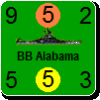ORIGINAL: Courtenay
ORIGINAL: warspite1
ORIGINAL: warspite1
warspite1
No one have any explanation on speed and how incorporated into the various factors by ADG?
warspite1
I found something in the old 1995/95 annual. ADG state that speed is factored into the attack and defence nos. i.e. the ability to choose when to fight and when to run is more easily gained/lost with high/low speed.
If we take range as well, range, this would seemingly leave movement allowance and that probably equates to speed (the effects of which are then limited by its range) to give "time on station" as mentioned above.
On that basis I think the treatment of the Independence-class (certainly in relation to the fast carriers) seems reasonable.
The speed of the
Independence was 31 knots
The speed of the
Enterprise was 32.5 knots.
The speed of the
Essex was 33 knots.
The speed of the
Iowa was 32 knots.
The speed of the
North Carolina was 28. This to me is a speed 5 ship.
warspite1
Yes, North Carolina has a movement allowance of 5. So not sure what you are suggesting exactly. Remember the movement allowance
on its own cannot be taken into account but range needs to be factored. If not then many destroyers could be 6's - but that would be rubbish because, despite their speed, they had low fuel capacity and thus range - and they are mostly 3's and 4's.
Independence is faster than the North Carolina but her range is much less than the battleship.
So they could be the same in terms of movement allowance/range because although the carrier is faster, she is not able to stay at sea (time on station) for as long.
So looking at the ships you mentioned:
------------------- SIF factors---------------Real life
---------------Movement Range ---------Speed Range
Independence --- 5 ---- 5 ------------- 31.6 - 13000
Enterprise ------- 6 ---- 4 ------------- 32.5 - 12000
Essex ------------ 6 ---- 6 ------------- 32.7 - 15000
Iowa ------------- 6 ---- 6 ------------- 32.5 - 15000
North Carolina -- 5 ---- 5 ------------- 28.0 - 17450
Enterprise has only 12,000 range and so is a 4. Independence is not as fast but has a slightly better range and so is a 5. Essex and Iowa speak for themselves and so the anomaly is North Carolina, but she is given the same factors as Independence because although her top speed is the least of all of them, she has the highest ability to remain on station.
I cannot see an issue - but am only guessing based on what seems likely. Maybe an e-mail to Harry would help?






